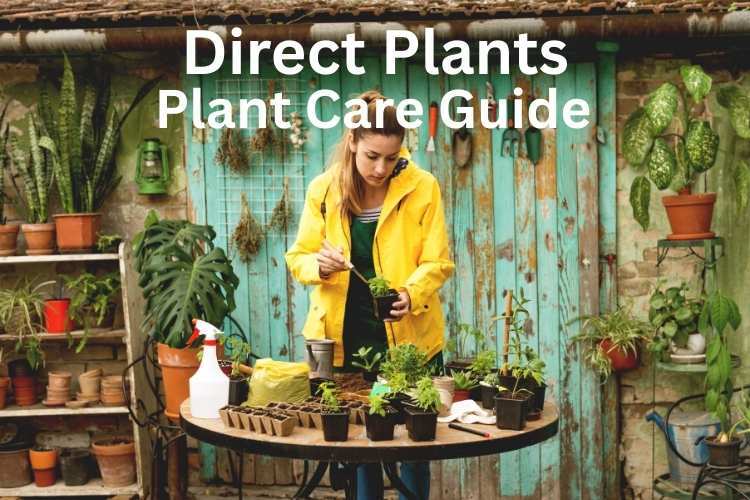
Thank you for choosing Direct Plants! To help your new plants thrive, we've created this comprehensive guide packed with detailed, easy-to-follow advice and practical tips. Whether you're planting in the ground or containers, you'll find everything you need here to keep your garden looking its absolute best.
Planting in the Ground
Check out the video below for advice on how to plant pot grown plants, trees, and shrubs. Below the video you'll find more tips on makign sure your new plant gets the best possible start:
Choosing the Right Location:
- Observe your garden carefully throughout the day to see how sunlight moves—full sun areas receive 6+ hours daily, partial shade about 4-6 hours, and shade fewer than 4 hours.
- Check soil drainage by digging a small hole and filling it with water. If it drains quickly, you're good; if water stays, improve drainage before planting.
Preparing the Hole:
- Dig a hole about twice as wide and just as deep as your plant's root ball.
- Add compost or well-rotted manure to enrich the soil, boosting nutrients for healthier plant growth.
Planting Steps:
- Carefully remove your plant from its packaging, gently teasing out any circling or compacted roots.
- Position the plant in the hole ensuring it's at the same depth as it was in its original container.
- Fill around roots with soil, gently firming down to eliminate air pockets, then water generously.
Watering and Mulching:
- Water deeply right after planting and at least twice weekly during dry conditions until plants are established.
- Spread a 5cm layer of mulch (like bark or compost) around the base to conserve moisture and deter weeds. Avoid piling mulch against the stem or trunk to prevent rot.
Planting a Bare Root Tree
Bare root trees aren't difficult to plant. This video will tell you all you need to know:
Planting in Containers
Choosing a Container:
- Select pots with multiple drainage holes and adequate size for root growth—larger containers mean less frequent watering.
- Terracotta pots dry out faster, while plastic retains moisture longer—consider your watering schedule.
Selecting Compost:
- Use a quality multipurpose compost mixed with grit or perlite for improved drainage.
- Consider adding slow-release fertiliser granules to nourish plants throughout the season.
Planting Steps:
- Place a layer of broken pottery, stones, or gravel in the base to improve drainage.
- Fill partially with compost, position your plant, and carefully backfill with compost around the roots, firming gently.
- Thoroughly water the container until moisture drains from the bottom.
Container Care:
- Regularly monitor container moisture levels, as pots dry out quicker. Water whenever the top inch of soil feels dry.
- Provide regular feeding with a liquid fertiliser every 3-4 weeks during the growing season.
New Plant Care Guide
Watering
- Aim to water deeply rather than frequently. Deep watering encourages roots to grow downward, creating more robust plants.
- Check the moisture level by pressing your finger into the soil—if it's dry to touch, it's time to water.
- Avoid overhead watering to minimise fungal diseases—use drip irrigation or water directly at the base.
Feeding and Fertilising
- Feed your plants every 4-6 weeks from spring through early autumn with a balanced fertiliser.
- Always follow packaging instructions to avoid overfeeding, which can damage your plants.
Pruning and Deadheading
- Regular pruning shapes plants, removes dead growth, and stimulates fresh growth. Deadheading spent blooms redirects energy to produce new flowers, enhancing blooming periods.
- Use sharp, clean tools to prevent disease transmission and clean cuts to promote rapid healing.
Weeding and Mulching
- Regular weeding prevents competition for nutrients and water.
- Mulch annually with organic materials like bark, compost, or leaf mould to enrich the soil and suppress weeds.
- For more info and tips watch the video below:
Seasonal Care Tips
- Spring/Summer: Keep a close eye on your plants' watering needs, increase feeding, and inspect frequently for pests.
- Autumn/Winter: Reduce watering gradually, clear fallen leaves promptly, and protect tender plants from harsh frosts using horticultural fleece or move containers indoors or under shelter.
Troubleshooting Common Problems
Watering Issues
- Yellow leaves: Often indicate excessive watering or poor drainage—let the soil dry slightly and improve drainage conditions.
- Wilting or crispy leaves: Usually due to lack of water—soak deeply and adjust your watering frequency.
Leaf Problems
- Brown leaf edges or tips: Can be caused by underwatering, sun scorch, or excess fertiliser—review watering and fertiliser use.
- Spotted or discoloured leaves: Suggest pests or fungal infections—treat with appropriate natural or chemical controls.
Pest and Disease Control
- Insect chew: Minor nibbling or small holes in leaves is perfectly normal and part of nature. For example, roses often get small holes from beetles or caterpillars—don’t panic, the plant will recover. We avoid using harmful chemicals whenever possible, and a little insect activity won’t harm your plant’s health—it often stimulates fresh growth.
- Aphids, slugs, caterpillars: Check the undersides of leaves regularly. On young shoots, you may see clusters of aphids—simply wash off with a strong spray of water or use eco-friendly solutions such as insecticidal soap or neem oil. For slugs, try beer traps or copper tape around pots.
- Fungal Issues (black spot, powdery mildew): Common on roses and cucurbits. Increase airflow around your plants, avoid overhead watering, remove affected leaves promptly, and apply fungicides when needed.
Seasonal Leaf Changes
Deciduous plants turning yellow or brown in autumn: From September to November, depending on the weather, it’s natural for deciduous trees and shrubs to change colour and drop leaves as they prepare for winter. Some varieties change earlier, some later, but all are simply following their natural seasonal cycle.
Plant Stress After Planting
Droopy appearance: Newly planted specimens can look a little tired or floppy due to transplant stress. This usually resolves with time as roots establish. Check soil moisture—too much or too little water can worsen drooping. Adjust watering accordingly and give the plant time to settle.
Delivery Concerns
Damaged or wet boxes: Our packaging is designed to protect plants during transit, so boxes may arrive scuffed, torn, or damp. This means they’ve done their job. Minor leaf or twig loss is not a concern—plants recover quickly, often growing back stronger. However, in the rare case of serious damage such as a broken main stem, please contact us with photos so we can help.
However, we pride ourselves that our packaging is the best in the business. All our plants and trees are carefully packed and protected in specially design packaging. If you need any reassurance on how well your plants will be packaged when they are delivered to you, take a look at the video below:
Reviving Stressed Plants
- Wilted or dry plants: Provide immediate deep watering. Continue regular watering and monitor closely.
- Repotting: Repot stressed plants in fresh compost and slightly larger containers to encourage root growth.
Apply gentle feeding after plants show signs of recovery.
Frequently Asked Questions (FAQs)
How often should I water newly planted trees or shrubs?
Water deeply once or twice weekly during the first 6-12 months until fully established.
My plant isn't growing—what can I do?
Is it adequately watered? Has it been fed? Is it getting the right amount of sun? Adjust as necessary or consider relocating your plant.
Can I keep my plant in the original pot it arrived in?
Short-term, yes. Long-term, repotting or planting in the ground ensures healthier growth.
Why are leaves falling off my plant?
Leaf drop usually indicates stress from inconsistent watering, temperature fluctuations, or relocation—maintain consistent care.
How can I protect my plants from frost damage?
Use horticultural fleece or cloches overnight, or move potted plants to a sheltered area.
What's the best time of day to water plants?
Early morning or late evening are ideal times, reducing water evaporation and stress.
Can I use garden soil for container plants?
It’s better to use potting compost, as garden soil may lack proper drainage and nutrients for container plants.
How do I deadhead a flowering plant and why should I do so?
To deadhead, remove faded or dead flowers by pinching or cutting below the flower head. This encourages plants to produce more blooms and keeps your garden looking neat.
How do I know when my plants need repotting?
If you notice roots emerging from drainage holes, slowed growth, or soil drying quickly, it's time to repot.
Quick Reference Checklist
- Regular deep watering without waterlogging.
- Appropriate sunlight and soil conditions.
- Consistent feeding schedule.
- Regular pruning and deadheading.
- Proactive pest and disease monitoring.
Ready to plant more? See our full range of plants, ornamental trees, and of course don't forget we are also a leading manufacturer of polytunnels.

